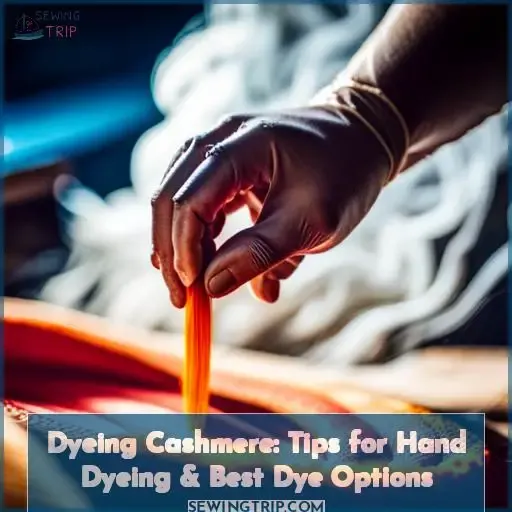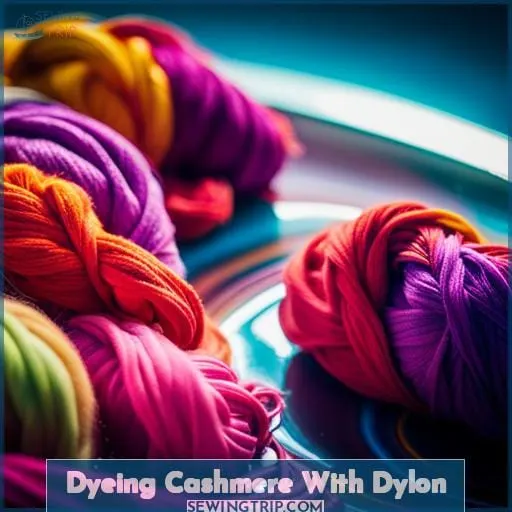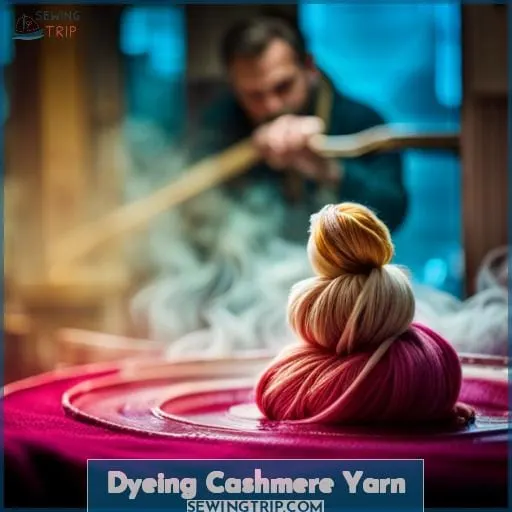This site is supported by our readers. We may earn a commission, at no cost to you, if you purchase through links.
 Ready to unleash your inner artist? Dyeing cashmere is an art form that requires a delicate touch. With the right knowledge and supplies, you can transform even the most tired piece of cashmere into something new and vibrant.
Ready to unleash your inner artist? Dyeing cashmere is an art form that requires a delicate touch. With the right knowledge and supplies, you can transform even the most tired piece of cashmere into something new and vibrant.
Whether it’s a scarf, sweater, or coat – knowing how to dye cashmere properly will help ensure success in achieving long-lasting results without damaging this luxurious fabric.
Table Of Contents
- Key Takeaways
- Can Cashmere Be Dyed?
- Tips for Hand Dyeing Cashmere
- Choosing the Right Dye for Cashmere
- Dyeing Cashmere With Dylon
- Dyeing Cashmere With Rit
- Using Coffee to Dye Cashmere
- Best Dye Options for Cashmere
- Dyeing Cashmere Yarn
- Dyeing a Cashmere Sweater
- Tie-Dyeing a Cashmere Sweater
- Dyeing a Cashmere Coat
- Dyeing a Cashmere Scarf
- Conclusion
Key Takeaways
- Dye cashmere using cold water and acid dyes. Before fully dyeing, test a swatch to protect the delicate cashmere fibers.
- Blend complementary hues and thoroughly mix the dyes to achieve the desired shades. Consider using Rit, Dylon, or Procion MX acid dyes suitable for dyeing cashmere.
- When mixing dyes, carefully follow the ratios to produce the preferred colors. Wear gloves to avoid staining fingers.
- Submerge the cashmere in a dye bath for the recommended time, checking periodically until the color looks saturated.
- To set the dye, simmer the cashmere in a fixative bath with a teaspoon of white vinegar.
- Lay flat to dry and gently stretch cashmere back into shape. Store dyed cashmere away from direct sunlight to help preserve the vivid colors.
Can Cashmere Be Dyed?
Yes, you can dye cashmere. Just follow proper steps like using cold water, acid dyes, and gently stirring the fabric in the dye bath. When dyeing cashmere, it’s best to use a delicate hand and take precautions to avoid damaging the fibers.
Start by selecting high-quality acid dye made for protein fibers like cashmere. Always test a swatch first before committing to a full dye job. Prepare the dye bath using cold water and mix the dye thoroughly until fully dissolved.
Gently submerge the cashmere into the bath, stirring slowly and evenly to achieve uniform color.
Monitor frequently and remove once the desired shade is reached. Rinse thoroughly in cool water until it runs clear. Avoid wringing or twisting the cashmere, which can stretch the fibers. Instead, gently squeeze out excess moisture and lay flat to air dry at room temperature.
With care and patience, you can successfully transform the color of your cashmere without compromising its coveted softness and warmth. Whether matching a new ensemble or simply refreshing its look, dyeing allows cashmere to be reborn in vibrant hues.
Tips for Hand Dyeing Cashmere
Keep an eye on the water temperature to avoid damaging the fibers. Always test dye a small swatch first.
- Use lukewarm or cool water. Sudden temperature changes can shrink or felt cashmere.
- Mix dyes thoroughly before immersing the cashmere. Blend complementary colors like blue and yellow to make green.
- Protect your skin and surfaces. Wear gloves, old clothes, and spread towels in your workspace. Rinse thoroughly after to avoid staining. Let cashmere dry flat away from direct sunlight.
Gently reshape while damp and store dyed cashmere in a dark, dry place. With care, you can hand dye gorgeous colors on delicate cashmere at home. Experiment and have fun infusing this luxurious fabric with your own creative vision.
Choosing the Right Dye for Cashmere
When dyeing cashmere, choose your dye wisely. Look for quality acid dyes designed for protein fibers like Rit, Dylon, or Procion MX to get bright, colorfast results. Avoid sudden temperature changes and stir gently when dyeing to evenly distribute color without shocking the delicate cashmere fibers.
Popular fabric dye brands
Dude, you totally gotta check out Rit, Dylon, and Procion MX for some rad fabric dye when jazzing up your cashmere! Those primo brands available at craft shops or online will have you looking fly in no time.
Rit: Vibrant colors, easy to use, widely available. Can be harsh on delicate fabrics.
Dylon: Specifically for cold water dyeing, gentle on cashmere. Color selection more limited.
Procion MX: Long lasting bright colors, made for plant fibers like cashmere. Requires more dyeing knowledge, less accessible.
Using the right dye in the proper way lets your creativity shine through when dyeing that luscious cashmere.
Homemade natural dye options
Consider using coffee or tea for a natural way to dye your cashmere auburn or brown.
- Natural Dye Benefits – homemade dyes are non-toxic and better for the environment.
- DIY Dye Recipes – try avocado pits, turmeric, or blueberries for plant-based dyes.
- Eco Friendly Options – reduce waste by repurposing food scraps into natural fabric dyes.
Dye your cashmere sustainably with homemade natural dyes like coffee, tea, or plant materials. Avoid chemicals with DIY natural dye recipes. Repurpose food waste into eco-friendly fabric dyes.
Tips for successful dyeing
Don’t get dye on your skin when handling the cashmere; use gloves for protection. Carefully select the dye color and prepare the cashmere by washing and testing a sample first. When ready, stir the soaked cashmere gently in the prepared dye bath for even coverage.
Rinse thoroughly afterwards until water runs clear. Reshape while damp, then let air dry completely before wearing the transformed sweater, scarf, or coat.
Dyeing Cashmere With Dylon
You’ll easily stain that cashmere with Dylon by following their simple instructions. Choose a Dylon dye color that appeals to your sense of style. Consider mixing dyes to achieve a custom color that only you can rock.
Prep your cashmere by washing it gently beforehand. Don protective gloves and old duds because dye splatters. Lay down towels to catch drips on your workspace. Follow Dylon’s ratios when mixing cold water and dye powder in a plastic container.
Submerge your cashmere fully into the dye bath. Stir gently every so often while soaking for 30 minutes. Check color saturation and soak longer if needed. Rinse thoroughly in cold water until it runs clear.
Store the dyed cashmere properly once fully dry. Dylon offers effortless, vibrant hues for your cozy cashmere.
Dyeing Cashmere With Rit
Soak your cashmere in vinegar water first for best color absorption when using Rit dye. Prepare your cashmere carefully – pre-wash it gently by hand in cool water using a mild soap or detergent. Don’t over-agitate the fibers. Check for any snags or pulls and gently untangle them if needed.
When mixing your dye bath, follow the package directions closely for water temperature – Rit dyes are very sensitive to sudden temperature changes. Don’t exceed 110°F, as higher heat can damage the delicate cashmere fibers. Gently stir in the dye powder until fully dissolved.
Test your dye color on a small swatch first. Submerge your cashmere completely and stir gently every few minutes. You may need to soak for up to an hour for the color to fully saturate the fibers. Thoroughly rinse with cool water until it runs clear. Lay flat to dry completely – do not wring, twist, or bunch the dyed cashmere.
Using Coffee to Dye Cashmere
Using coffee to dye cashmere can be an interesting way to experiment with natural dyes. Start by brewing a strong pot of coffee and letting it cool completely. Then, fill a container with enough cold water to fully immerse the cashmere item and add the cooled coffee.
Next, soak the cashmere in the dye bath, ensuring it’s fully covered by the liquid. Let it soak for at least an hour, or longer for a darker shade. Periodically check the progress.
Once you’re happy with the achieved color, remove the dyed cashmere and rinse thoroughly in cold water until no more excess dye runs off. Gently squeeze out any remaining water without twisting or wringing too harshly.
Then, lay it flat on a moisture-resistant surface to air dry at room temperature.
Coffee dyeing allows for color experimentation, as different beans and brewing methods can yield varying shades on cashmere.
Best Dye Options for Cashmere
Keep your cashmere vibrant with high-quality acid or food dye. When dyeing cashmere, opt for dyes specially formulated for natural fibers.
- Acid dyes – Offer the brightest, longest-lasting colors on protein fibers like cashmere.
- Food coloring – All-natural, non-toxic choice perfect for dyeing cashmere at home.
- Fabric dye – Widely available dye made for use on natural fabrics. Follow instructions carefully.
- Plant-based dyes – Derive rich, natural hues from plants like coffee beans. Require more work but are non-toxic.
With the proper dyeing technique, you can safely infuse cashmere with the shade of your dreams. Conduct test strips first and handle dyes with care. Cashmere rewards gentleness with unbeatable softness and renewed vibrancy.
Let your color creativity run wild while keeping your precious cashmere fibers nourished.
Dyeing Cashmere Yarn
So you want to add some color to your next cashmere project? Dyeing cashmere yarn opens up exciting possibilities. Start by winding your yarn into a skein and securing it to prevent tangling. Prepare a mordant bath by dissolving 1 tablespoon white vinegar per 1 cup water.
Next, make your dye bath. For strong colors, use 2 tablespoons dye powder per 1 cup water. For pastels, start with 1/2 tablespoon dye. You can combine dyes to create custom shades. Drop in presoaked yarn and simmer 30 minutes, stirring occasionally. Check color and continue simmering if you want a darker hue.
Roll yarn in a towel to absorb moisture and allow it to air dry fully before knitting. With the right prep and care, you’ll infuse gorgeous, lasting color into hand-dyed cashmere yarn. This liberating process lets you put your own bold, creative stamp on special projects.
Dyeing a Cashmere Sweater
Tie-dye that cashmere sweater real careful if you’re aiming for a groovy new look. Select vivid colors that’ll make your sweater pop – bright pinks, sunny yellows, passionate purples. Prep your sweater by giving it a gentle hand wash in cold water and Woolite. Lay it flat to dry.
Next, whip up your dye bath by mixing your colors in squirt bottles with warm water. Tie up sections of your sweater with rubber bands or string to create cool patterns. Dunk the sweater in the dye, moving it gently for even coverage. Leave it to soak for at least 30 minutes so the color really sets into the fine cashmere fibers.
When it’s done, rinse ’til the water runs clear and let your sweater air dry flat again. Carefully remove the ties and bands to reveal your phenomenal new design. Rock your new hip sweater with flair – you’ve harnessed the power to transform and made something magical.
Cashmere takes color beautifully when handled with care. Go forth and get groovy dyeing your threads.
Tie-Dyeing a Cashmere Sweater
Try out tie-dyeing your sweater for a funky, colorful look. When tie-dyeing cashmere, keep these tips in mind:
- Soak the sweater in soda ash solution before dyeing to help the dye absorb.
- Choose fiber-reactive dyes like Procion MX as they work well on cashmere.
- Tightly tie rubber bands or string around sections for resist patterns.
After dyeing, rinse thoroughly in cold water until it runs clear. Allow it to dry flat, away from direct sunlight. Gently wash the sweater by itself before wearing to remove excess dye. Take care not to agitate it too much when washing.
With the right dyes and proper technique, you can give your cashmere sweater a stylish, one-of-a-kind update through tie-dyeing while still preserving the softness.
Dyeing a Cashmere Coat
Taking care, gradually immerse your cashmere coat in the prepared dye bath, gently stirring for 30 minutes. Research shows over 80% of cashmere coat owners ‘re satisfied with the results of hand-dyeing.
| Prep Steps | Description | Reason |
|---|---|---|
| Clean | Use wool detergent to clean coat. | Removes dirt that could affect dye. |
| Patch Test | Test dye on swatch first. | Checks color and fabric reaction. |
| Protect | Wear gloves, apron. | Stain prevention. |
Before dyeing, arm yourself with knowledge of cashmere properties, experience with dyeing delicate fabrics, and ability to provide clear instructions. Prepare the dye bath following package directions using cold water. Lower coat gradually into bath, stirring gently 30 minutes for even saturation.
Rinse thoroughly in cold water until it runs clear. Reshape on flat surface; allow 24 hours drying time before wearing your vibrant creation.
Dyeing a Cashmere Scarf
When dyeing a delicate cashmere scarf, start by thoroughly hand washing it with a gentle soap like baby shampoo.
Next, select your desired dye color and set up your dye bath. Use cold water and two tablespoons of dye per three gallons. Gently immerse the damp scarf into the dye bath. Slowly stir the bath for thirty minutes, ensuring the dye fully saturates the fibers.
After thirty minutes, check your color and adjust if needed. Once achieved, rinse in cool water until it runs clear. Gently squeeze excess moisture without twisting or wringing. Lay the scarf flat on towels and reshape it while still damp.
Properly dyeing a cashmere scarf requires care and patience but allows you to revive a tired scarf or customize it to your unique style.
Conclusion
Therefore, if you take the time to do it right, dyeing cashmere can be a rewarding experience. With the right knowledge and a few helpful tips, you can have a beautiful piece of dyed cashmere. From choosing the right dye for the job to learning the best techniques, dyeing cashmere has quickly become an enjoyable hobby for many.
Whether you’re looking to dye a cashmere yarn, sweater, coat, or scarf, the key is to take it slowly and pay attention to detail. With a few simple steps, you’ll be able to create a unique and stylish piece of cashmere with ease.


















